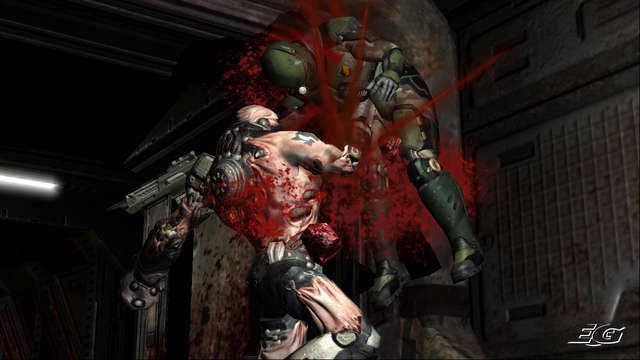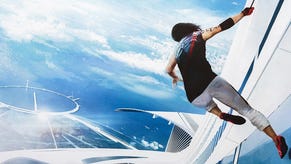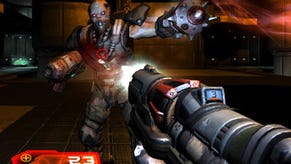Quake 4
Browned off.
There used to be a good excuse for console conversions of Quake games being a bit rubbish. Anyone who recalls the hapless early attempts on PlayStation and N64 might not wish to be reminded, but then no-one was exactly surprised, either. Porting cutting-edge PC shooters to ageing home systems is generally a one-way ticket to Jerksville - but the fact that we're still able to come to similar conclusions on a next generation system that's arguably more powerful than most people's PCs is pretty unforgivable.
Ok, so Quake 4 on 360 is hardly in the same league as the PSX Quake II, but as an example of a badly optimised, undernourished port, this is by far the worst example we've seen to date. Even in its full high definition glory, textures are far blurrier than you'd expect, the game chugs along unsatisfyingly even when there are no enemies on screen, and it even crashes from time to time - a pretty alarming state of affairs. It's not unplayably bad, though, and if you hadn't already played the PC version on a decent system you might be reasonably pleased with what's on show. But don't be fooled: that was no reason for id, Raven and Activision to allow this out of the door simply to make it for the system's launch.
Even if it was the sweetest, slickest conversion we'd ever seen, Quake 4 simply isn't up to scratch in any case. It fails to engage right from the beginning, being the kind of rigidly linear, underwhelming, undemanding, by-the-numbers sci-fi schlock that joins the dots with done-to-death gameplay. If, half an hour in, you feel like you've played Quake 4 before, that's because you probably have. In about 47 previous first-person shooters over the past 10 years.
Brown boy in the ring
Unlike the nameless, story-free efforts of the past, Quake 4 does at least try and lend a sense of purpose to the endless traversing of brown corridors. Having defeated the Makron at the end of Quake II, the clean-up operations goes a tad awry when Rhino squad's dropship is shot out of the sky, leaving you in charge of new recruit Matthew Kane battling through the ruins for survival.
With the Strogg base in disarray and the human forces equally disorganised, the opening sections blur past with a sense of uneasy panic on both sides, with several escort missions involving protecting medics, bomb defusal and demo specialists. Your role is of bodyguard and chief button-presser, essentially, making it pretty easy for Raven to design a straightforward run-and-gun with lots of brutish, gurning Strogg to mop up every time you turn a new corner.
The game essentially carries on in this plodding vein throughout, barely able to conceal its lack of ambition with one routine button-pressing task after another. In-between 'interacting' with consoles, flicking switches on or off and dispatching willing sentries one after the other, you get to engage with the odd on-rails section, or even saddle up inside a mech or pilot a beefy tank and dish out some death to equally enormous enemies. But, like much of the game, it's pretty undemanding stuff, giving you a recharging shield that makes it far, far too easy to just blast your way to unsatisfying victory. In a game dominated by such tight, confined environments it's practically impossible to get lost, with almost every pathway likely to lead you directly to your next button-pushing assignment. Tightly scripted action isn't the problem, though, it's just that Raven seems content to keep the script as uncomplicated as possible.
Brownian motion

If the idea was to create a back-to-basics, balls-out shooter, then it succeeds on a basic (read: very basic) level, but doesn't even get that right often enough. The familiar roster of weaponry is as much to blame as anything, either giving you super-powered weapons that take all the tension and fun out of the combat, or stupidly hamstrung weapons you won't want to use. To start off with you get a chargeable pistol you'll barely ever need or want to use, very quickly (as in: within a minute) followed by a machinegun with a zoom function that makes it too easy to kill everything from afar, a shotgun that's useful close up but takes too long to load, a powerful chaingun that takes too long to spin into action, a grenade launcher you have barely enough ammo for, and eventually the more powerful nailgun, hyperblaster, railgun, rocket launcher and the BFG-esque, all-consuming Dark Matter gun. Amusingly, you can still carry every single one, too, so there's not even any need to strategise in the heat of battle - it's just a case of unloading everything you've got until they're gone, and never really worrying too much about preserving ammo. It's as straightforward an FPS experience as we've played in, well, years, which isn't actually a compliment.
Even on the harder settings - where a few hits is enough to send you packing - the enemy AI is still dumb and inflexible, largely standing its ground and simply loosing off rounds for the sake of it. If they hit you, it's more likely because you strayed into their line of fire, rather than was the victim of a determined enemy that's stalking its prey. And why is it - still - that enemies are allowed to have infinite reserves of ammo and don't suffer the health concerns that you do? We want fire-fights that vaguely resemble a future war against an alien menace, not yet another dumb load of bots that provide us with duck shoot cannon fodder. The presence of semi-useful buddy AI colleagues is fairly useless too, never sticking around long enough for you to care enough for them, taking way too much damage to be credible, and full of sterile one-liners just to make their existence even less welcome. Why do FPS makers seem to always assume it's enough to make the corridors prettier, the lighting more atmospheric and the buddy AI more talkative? This sort of brainless retread of decade old game design isn't enough anymore.
A lot of the concerns people had about Doom III apply here, but without the tension or sense of the unexpected. Sure, some people hated the old-school 'it's behind you' mechanic, and fair enough, but anyone who played that game into hell and beyond will remember it for being a game that turns up the heat to an insane degree and really paced itself exceptionally well. Quake 4's cardiograph, on the other hand, blips along comfortably, never really threatening to do anything unexpected or out of the ordinary; in the sense of its combat, puzzles or narrative. In all three areas there's literally nothing going on that we haven't seen done far better elsewhere, which is the crushing realisation you'll probably come to after seeing it through. Second time around, it's even more apparent.
Brown frown

Raven had a chance to do something amazing with Quake 4 about halfway through - and if you're one of the two people left that hasn't already heard the 'twist', then we won't ruin that for you - but suffice to say that nothing significant changes, and the game simply picks up from where it left off with the single, startling innovation being that you can use the wall-mounted units to recharge your health. Whoop-de-doo.
Up until now, we've not even been moved to talk about the amazing high definition visuals that use the groundbreaking Doom III engine, or anything of the sort - mainly because you've seen most of what the game has to offer within the first few gloomily lit corridors. On a basic level, yes, the game is built on an engine that's capable of great things, but we'd be damned if Raven has gone to any great lengths to find out what Jon Carmack's tech can do. We've said it before, but it really is the brown Doom. It's a brown planet, with a series of brown bases built on top of it, with brown pipes snaking around it, so whether you're fighting indoors or not, what you see doesn't vary a great deal. The fact that the enemies are highly detailed and that the wall texturing is relatively intricate won't feel of great consequence after the first few minutes, because you'll see much the same thing for the 12, 15 hours it'll take you to polish it all off. There's no real sense of interaction, no means of destroying your surroundings in any way, no physics implementation worth a damn, and your sense of frustrated boredom will creep in once the penny drops that the variety consists of brown pipes or brown rock.
On the positive side, the controls work pretty well, with all the default settings not requiring any meddling at all and the general look sensitivity seems spot-on. The aiming's possibly a little more forgiving than the PC original, making the game slightly easier than we remember it first time around, so be sure to ramp up the difficulty accordingly as it's just way, way too easy otherwise - especially given you can quicksave at any point. One niggle, though, is the irritating decision to map crouch to the left stick, as you'll forever find yourself ducking down when you don't want to, and feel uncomfortable trying to aim precisely with your thumb clamped down. It's not as if the 360 pad is lacking buttons.
Doomed

As for multiplayer, it's all bad news. Not only has Raven been unable to match the 16-player support of the PC original (supporting a miserly eight here, but no four-player split-screen option, which is a surprising omission), we're subjected to a thoroughly out-moded selection of 'oh-my-god-is-that-it?' maps and modes that belong firmly in the past. It ticks the usual deathmatch/team deathmatch/Capture the Flag/Team CTF boxes, and throws in one-on-one Tourney (that's Tournament) rather apologetically. Bizarrely, the usual Xbox Live implementation is slightly borked, and searching for matches is an usually painful process, while in-game the frame rate is just as bad as the iffy single-player experience. Damn their eyes.
If you were generous, you'd be happy at the return to simplicity of the late '90s, complete with Quake III-style jump pads, some old fondly remembered maps and the booming commentator voice, but as we all know, nostalgia is fleeting at the best of times. Before long, you'll probably be hankering after something that looks forward, not back. Let's hope Quake Wars fills that particular role.
It says a lot about the excitement value of Quake 4 when the most exciting part of the package is the presence of Quake II on the making-of-laden bonus disk. Playing that particular classic on a whopping great screen does serve as a timely reminder of how far we've come in technical terms in the eight years that have elapsed since then, but also underlines how incredible it is that Quake 4 still manages to feel so unimpressive and irrelevant by comparison.
This eight-year gap between Quake single-player offerings gave Raven the perfect opportunity to deliver something very special that not only reinvigorated the brand, but showed off next generation FPS design. That Quake 4 is merely a glossy, standard, by-the-numbers trudge through past glories is an irresponsible way to treat such a revered franchise; to then cock up the conversion to the 360 subsequently and then charge extra for the privilege is bordering on scandalous.





